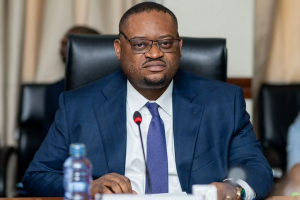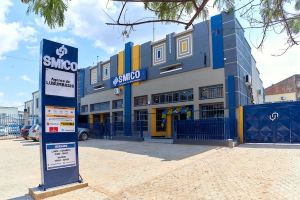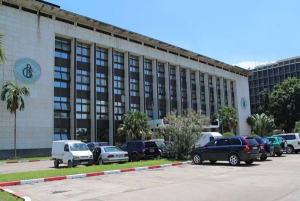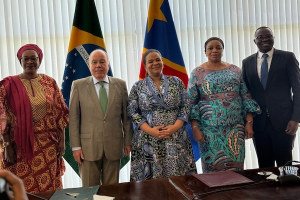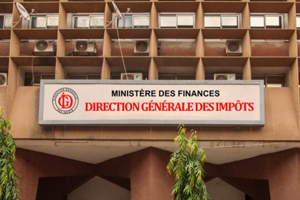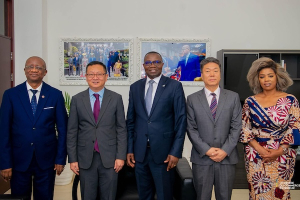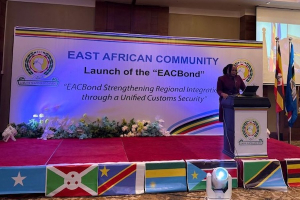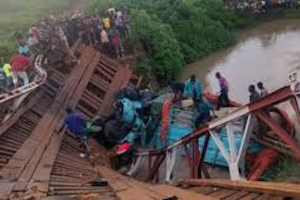Equipe Publication
Développement : la RDC crée un Fonds d’investissement stratégique
Le gouvernement congolais a adopté, lors du Conseil des ministres du 15 août 2025, un projet de décret portant création du Fonds d’investissement stratégique de la République démocratique du Congo (FIS-RDC), présenté par le ministre des Finance, Doudou Fwamba (photo). Cette décision marque le début de la concrétisation du projet de fonds souverain, évoqué lors du Conseil des ministres du 6 juin dernier.
Après la signature du décret, plusieurs étapes restent à franchir : la nomination des dirigeants, la mise en place opérationnelle de l’institution et le démarrage effectif de ses activités. Aucun calendrier précis n’a encore été communiqué à ce sujet. En revanche, les contours de ses missions sont désormais mieux définis.
D’après le compte rendu du Conseil, le FIS-RDC aura pour mission de mobiliser et structurer des financements afin d’accélérer la mise en œuvre de la stratégie nationale de développement. Il s’agira aussi de renforcer l’inclusion territoriale, de soutenir la diversification économique et de renforcer sa souveraineté.
Le fonds devra ainsi rechercher des financements innovants, en s’appuyant sur des instruments financiers modernes, au-delà des modèles traditionnels de prêts et d’aides. Il pourra investir dans des secteurs stratégiques comme les infrastructures, l’énergie, les technologies, l’agriculture, l’immobilier ou encore l’industrie. Le FIS-RDC sera également chargé de valoriser les actifs de l’État et de favoriser les partenariats avec des investisseurs privés ou institutionnels, nationaux et étrangers. Le tout devra s’inscrire dans un cadre transparent, respectueux des normes environnementales et sociales, et guidé par des exigences de performance.
Parallèlement, le gouvernement congolais travaille à la création d’une Caisse des dépôts et consignations (CDC) et d’une Banque de développement. Présentées au Conseil des ministres du 4 juillet, ces structures visent à centraliser les ressources publiques éparpillées dans le système bancaire et à les réorienter vers des projets prioritaires. La Banque de développement, future filiale de la CDC, devrait disposer d’un capital de 150 millions de dollars. Elle aura pour rôle d’offrir des financements de long terme afin de réduire la dépendance du pays aux emprunts extérieurs et de renforcer sa résilience financière.
Boaz Kabeya
Lire aussi :
Titres publics : la RDC prépare une réforme pour diversifier les investisseurs
Deux nouvelles institutions financières pour stimuler l’investissement en RDC
Un fonds souverain pour financer les ambitions de développement de la RDC
Kolwezi : construction annoncée du premier double échangeur routier de la RDC
La province du Lualaba s’apprête à lancer la construction du premier double échangeur routier de la République démocratique du Congo (RDC), à Kolwezi, capitale provinciale et principal centre minier du pays. Le démarrage des travaux est prévu pour cette année 2025. Ils seront exécutés par deux filiales du groupe Forrest : Malta Forrest, chargée de la conception et de la construction, et Congo Energy, responsable de l’éclairage public solaire.
L’ouvrage sera érigé à un point stratégique : le rond-point Mwangeji, situé au croisement des avenues Lumumba, LDK, Mandradele et de la RN39. Ce projet, initié par le gouvernement provincial, vise à désengorger le trafic routier dans une ville en pleine expansion. Il prévoit la construction de cinq ponts, plusieurs bretelles de raccordement, près de 3,5 kilomètres de routes et l’installation de 240 lampadaires solaires le long des rampes, ponts et voies d’accès.
Le coût du projet n’a pas encore été communiqué, et peu de détails ont été fournis concernant la nature exacte de la collaboration entre le Lualaba et le Groupe Forrest. Cependant, ce dernier avait déjà réalisé le premier échangeur de Kolwezi, inauguré en juin 2025 par le président Félix Tshisekedi, près de l’aéroport. À cette occasion, la gouverneure du Lualaba avait indiqué que ce type d’infrastructure s’inscrivait dans le cadre du programme d’investissement prioritaire 2024–2028, dans son volet « infrastructures de transport ».
Fondé en 1922, le groupe Forrest est un conglomérat industriel d’origine belge, historiquement implanté en RDC. Il est considéré comme l’un des principaux acteurs privés – et familiaux – encore présents dans le pays depuis l’époque coloniale. Le groupe joue un rôle central dans le développement des infrastructures de transport et des services au secteur minier, deux domaines clés pour l’économie congolaise.
Ronsard Luabeya
Lire aussi:
Foires commerciales: des infrastructures modernes en projet à Matadi et Muanda
Dans le cadre de la relance des foires commerciales en République démocratique du Congo (RDC), de nouvelles infrastructures modernes sont en projet à Matadi et à Muanda, dans la province du Kongo Central.
Le 19 août 2025, une délégation de la société chinoise Chongqing Civil Engineering Construction Cooperation (CCECC) a inspecté les sites retenus dans les deux villes. Conduite par le ministre provincial du Tourisme et des représentants de la Foire internationale du Congo-Kinshasa (FICKIN), la mission a été accueillie par le vice-gouverneur Prospère Ntela Ntambidila.
Selon la cellule de communication du gouvernorat, les échanges ont porté sur la présentation des projets, les études de faisabilité ainsi que le suivi des procédures administratives et foncières. Le directeur de la Foire provinciale, Hypollite Mukunde, a indiqué que plusieurs recommandations ont été formulées par le vice-gouverneur afin d’accélérer le processus. L’objectif est de renforcer l’attractivité touristique et commerciale du Kongo Central.
Cette initiative s’inscrit dans la stratégie du ministère du Commerce extérieur, qui a demandé aux provinces de réserver des terrains pour l’implantation d’infrastructures foraines. Le Kongo Central a ainsi mis à disposition 50 hectares, répartis entre Matadi et Muanda.
D’autres provinces ont également répondu à cet appel : le Maniema avec 100 hectares, le Lualaba avec 50 hectares, tandis que la Tshopo attend encore confirmation de la superficie allouée. Ces espaces accueilleront foires, expositions et autres événements économiques destinés à valoriser les potentialités locales et régionales.
Ronsard Luabeya
Lire aussi :
Foires : la RDC structure le secteur pour promouvoir le savoir-faire local
SMICO : résultats solides en 2024, mais perspectives incertaines en raison du conflit à l’est
En 2024, la Société de microcrédit congolais (SMICO SA), basée à Goma, a réalisé des résultats solides : un bénéfice net de 6,01 milliards de francs congolais, soit environ 2,1 millions de dollars, en hausse de 26 % par rapport à l’année précédente. Son portefeuille de crédits a atteint 101,8 milliards de FC (35,7 millions de dollars), en progression de 43 %, tandis que l’épargne collectée a culminé à 110,5 milliards de FC (38,8 millions de dollars).
Ces performances laissaient entrevoir une trajectoire ascendante en conformité avec son plan stratégique 2023–2027. Dans ce plan, la microfinance vise notamment à porter son portefeuille de crédits à plus de 65 millions de dollars au profit de près de 30 000 micros, petites et moyennes entreprises (MPME), et à dégager un bénéfice net supérieur à 7 millions de dollars à l’horizon 2027.
Cependant, cette dynamique est aujourd’hui compromise par la dégradation sécuritaire dans l’est du pays. Depuis janvier 2025, les villes de Goma et de Bukavu, où se trouvent respectivement le siège et une agence importante de la SMICO, sont sous occupation du M23. Cette situation a entraîné la fermeture des deux agences, perturbant les activités de collecte de l’épargne et de distribution des crédits dans ces zones stratégiques.
Avec un réseau de 10 agences fin 2024 et un total de 82 003 clients, la SMICO compte étendre sa couverture à 12 agences et 110 000 clients d’ici 2027. L’institution vise aussi à mobiliser jusqu’à 70 millions de dollars d’épargne et à développer un réseau de 150 agents bancaires et 40 agents marchands, avec en ligne de mire un chiffre d’affaires de 25 millions de dollars. Mais la fermeture prolongée de ses agences de Goma et Bukavu menace ces objectifs.
Sur le plan de la couverture des emprunteurs, la SMICO a conclu en juillet 2025 un partenariat avec RAWSUR Assurance afin d’assurer l’intégralité de sa clientèle contre les risques, comme prévu. Ce partenariat prévoit aussi la commercialisation de produits d’assurance diversifiés, notamment vie, santé, automobile, incendie et voyage.
Il faudra attendre la publication de ses prochains résultats pour mesurer l’impact concret de l’instabilité sécuritaire de 2025 sur le développement de la SMICO et sur sa capacité à tenir ses engagements dans un environnement aussi incertain.
Timothée Manoke, stagiaire
Lire aussi
Conflit à l’est de la RDC : déjà en difficulté, CADECO subit un coup dur à Goma
Paiement des salaires : les solutions de Rawbank et Equity BCDC à l’est de la RDC
Conflit à l’est de RDC : des « pertes considérables » pour les entreprises
DRC Prepares Roadmap to Reform Public Securities Market
Highlights:
• IMF-backed roadmap to be adopted by December 2025
• Focus on transparency, investor diversification, and secondary market
• Bill on mutual funds expected by end of 2025
The government of the Democratic Republic of Congo, in collaboration with the Central Bank of Congo (BCC), plans to adopt a roadmap by December 2025 "to improve the functioning of the public securities market." The International Monetary Fund (IMF) disclosed this in its latest report, released last month.
The roadmap, based on IMF recommendations, will emphasize better planning, predictability and transparency of the issuance process, aligning auction schedules with the annual borrowing plan and the overall debt management strategy.
Another key priority is diversifying the investor base beyond banks, which currently hold 99% of securities. Under the new strategy, training workshops will be regularly held for non-bank investors, while insurance companies will face a compulsory minimum subscription. A bill amending the Insurance Code was passed in April but has yet to be submitted to Parliament.
The plan also includes measures to spur a secondary market, such as differentiated coupons by maturity to improve price formation and liquidity. Authorities will also submit a bill on mutual funds to Parliament by the end of December 2025.
With this roadmap, the DRC aims to deepen its securities market and extend maturities to reduce refinancing risks. For now, the market remains shallow: outstanding public securities rose from 0.14% of GDP in 2019 to 1.65% in December 2024, still dominated by fractional repayment Treasury bills with average maturities of just 18 months, representing 90% of the total.
Boaz Kabeya
DRC, Brazil Strengthen Ties with New Bilateral Agreements
Highlights:
• Kinshasa and Brasília sign multiple agreements covering visas, diplomatic work, and military cooperation.
• Collaboration expands to agriculture, health, environment, and electoral projects.
• Trade reached a record $259 million in 2024, up 28% from the previous year.
The Democratic Republic of the Congo (DRC) and Brazil signed several agreements and memorandums of understanding on August 11, reinforcing diplomatic, security and economic cooperation, the DRC government said.
The agreements include visa exemptions for holders of special passports and authorization for paid work for diplomats’ dependents. In the security sector, both countries pledged to strengthen the operational capabilities of the DRC Armed Forces (FARDC), acquire equipment, exchange expertise in the military industry, and train special jungle units.
“The signing of these agreements testifies to the shared desire of the two States to consolidate their diplomatic relations in the service of the well-being of their peoples,” the DRC Ministry of Foreign Affairs said on X.
The countries also collaborate on strategic sectors including agriculture, health, biofuels, environment, and elections. A technical cooperation program launched in 2022 trains small-scale Congolese agricultural producers.
Trade between the two nations hit a record $259 million in 2024, up 28% against 2023. Last year, Brazil exported $191.5 million worth of sugar, poultry, and pork to the DRC while the Central African nation exported crude oil valued at $67.6 million. In 2023, Félix Tshisekedi became the first Congolese president to pay an official visit to Brazil.
Lydie Mobio
Mining, Oil, and Industry: Tax Exemptions Hamper DRC Revenue, World Bank Report Finds
Highlights:
• Tax breaks for mining, oil and industry cost over 3% of GDP in 2023
• Exemptions absorb 75% of lost revenue, but jobs grew just 3% in 2024
• World Bank urges targeted incentives, more transparency and efficiency
The Democratic Republic of Congo (DRC) grants significant tax exemptions to the mining, oil and industrial sectors, but their impact on employment remains limited, according to the World Bank’s report “Reassessing Tax Incentives – Far from the Promised Growth and Equity” published at the end of July 2025.
The report estimates that tax expenditures, mainly from corporate income tax (CIT) and value-added tax (VAT) exemptions, accounted for over 75% of lost public revenue. In 2023, they represented 1.6% of GDP for the mining sector, 1.5% for oil and 0.7% for industry. By contrast, employment grew only 3% in 2024, with the labor market still dominated by informality and insecurity.
Although the DRC’s corporate tax rate of 30% is above the African average of 28%, the country offers temporary exemptions of three to five years in certain economic zones, coupled with customs and tax benefits. But the World Bank warns that these schemes are “often poorly targeted and profit-based,” distorting investment choices and even encouraging companies to delay projects until exemption periods expire.
Instead, the institution recommends replacing broad exemptions with targeted measures such as accelerated depreciation, while broadening the tax base and ensuring greater transparency. It further calls for rationalizing tax expenditure, harmonizing rates and strengthening budget analysis to enhance efficiency, equity and domestic revenue mobilization.
Ronsard Luabeya
China, DRC to Finalize Duty-free Export Deal within 60 Days
Highlights:
• Beijing, Kinshasa move closer to duty exemption deal for Congolese exports.
• Agreement expected to boost shipments of soybeans, sesame, coffee, cocoa, and chillies.
• Talks build on China’s unilateral decision to scrap tariffs for 33 African nations.
The Democratic Republic of Congo (DRC) and China are finalizing a duty-free export agreement expected to be completed within 60 days, Congolese Commerce Minister Julien Paluku said after meeting Chinese ambassador Zhao Bin in Kinshasa on Friday.
The move follows a September 2024 memorandum of understanding signed in Beijing granting DRC exemptions on exports to China. Negotiators from both sides have been tasked with drafting the final text, which will also involve the Agriculture Ministry to align local production with export plans.
The deal is structured around trade facilitation, inclusive development, supply chain resilience, industrial upgrading and the use of e-commerce and e-payments, according to the ministry.
Under the agreement, Kinshasa aims to ship one million tonnes of soybeans, 20,000 tonnes of sesame, 10,000 tonnes of chillies, 5,000 tonnes of coffee and 3,000 tonnes of cocoa to China.
The talks come after Beijing scrapped customs duties, without compensation, on imports from 33 African low-income countries, including the DRC.
Ronsard Luabeya
East African Community Launches Single Electronic Customs Bond
Highlights:
• New EAC system replaces multiple national bonds, unlocking nearly $2B in tied-up capital.
• First phase covers Uganda, Kenya and Rwanda, full rollout expected across all EAC states by 2026.
• Traders benefit from lower costs, faster transit, and real-time cargo tracking via RECTS.
On August 4, 2025, in Kampala, the East African Community (EAC) launched a single electronic customs bond to replace the multiple national bonds previously imposed on goods in transit, in a bid to cut costs and speed up border crossings across the region.
Until now, traders had to deposit sums as security with each country’s customs administration or subscribe to the Common Market for Eastern and Southern Africa (COMESA) bond. According to the EAC, nearly US$2 billion was immobilized in this way. The new system will free up part of this capital for reinvestment in the regional economy.
The COMESA bond was not recognized in Tanzania, a key EAC member through which much of the trade to the Democratic Republic of Congo (DRC) transits. The EAC’s single bond aims to bridge this gap.
The scheme is being rolled out first in Uganda, Kenya and Rwanda, with full coverage of all member states expected by 2026. Under the mechanism, for example, a Congolese trader unloading goods in Mombasa will be able to take out one bond valid through Kenya and Uganda up to the DRC. The same will apply to Dar es Salaam, Tanzania, once the rollout is complete.
Each transit bond corresponds to one cargo or one trip, with maximum coverage capped at $150,000. The cost is set at 0.3% of the value of containerized goods, which must be sealed by customs and monitored in real time through the Regional Electronic Cargo Tracking System (RECTS).
Unlike COMESA’s model, the new bond also allows operators to subscribe to optional products covering physical loss or damage to cargo, containers, and accident insurance for drivers.
Timothée Manoke (intern)
Kibi Bridge Collapse Halts Trade Between DRC and South Sudan
Highlights:
• Key bridge linking Ingbokolo to South Sudan collapsed under truck load
• Deputies press governor for urgent rehabilitation, question Petro-City’s role
• Structure built in 1956 had collapsed twice before, last repaired in 2020
A bridge linking eastern Congo’s Aru territory to South Sudan collapsed last week, cutting off trade and cross-border movement and raising concern among provincial lawmakers.
The Kibi bridge, which connects Ingbokolo to Kengezi-Base, gave way under the weight of a goods truck on Aug. 14, halting traffic along one of the main commercial routes to South Sudan. The closure has stalled customs revenue collection at Kengezi-Base, a key border post.
In a letter to the military governor of Ituri, provincial deputies urged the urgent rehabilitation of the bridge and sought clarification on whether Petro-City, which has been rehabilitating nearby roads since April 2024, would take on the project.
The 26-metre structure, originally built in 1956 to support 20 tonnes, was previously rehabilitated in 2020 after an earlier collapse in 2006. Local authorities steered the work, with support from the Fédération des Entreprises du Congo (FEC).
Ronsard Luabeya





